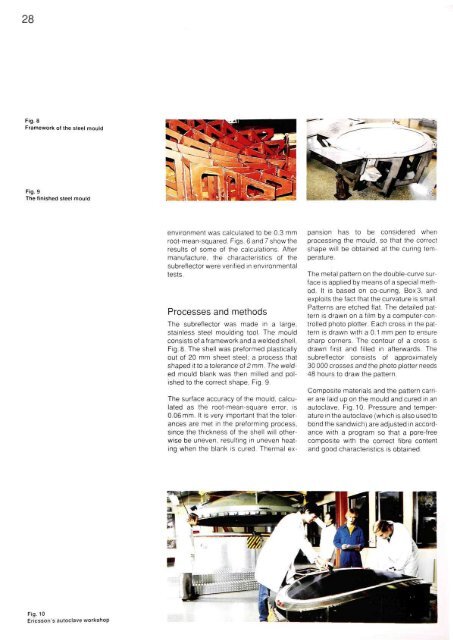Dichroic Antenna Reflector for Space Applications CCITT ...
Dichroic Antenna Reflector for Space Applications CCITT ...
Dichroic Antenna Reflector for Space Applications CCITT ...
Create successful ePaper yourself
Turn your PDF publications into a flip-book with our unique Google optimized e-Paper software.
Fig. 8Framework of the steel mouldFig. 9The finished steel mouldenvironment was calculated to be 0.3 mmroot-mean-squared. Figs. 6 and 7 show theresults of some of the calculations. Aftermanufacture, the characteristics of thesubreflector were verified in environmentaltests.Processes and methodsThe subreflector was made in a large,stainless steel moulding tool. The mouldconsists of a framework and a welded shell,Fig. 8. The shell was pre<strong>for</strong>med plasticallyout of 20 mm sheet steel; a process thatshaped it to a tolerance of 2 mm. The weldedmould blank was then milled and polishedto the correct shape, Fig. 9.The surface accuracy of the mould, calculatedas the root-mean-square error, is0.06 mm. It is very important that the tolerancesare met in the pre<strong>for</strong>ming process,since the thickness of the shell will otherwisebe uneven, resulting in uneven heatingwhen the blank is cured. Thermal expansionhas to be considered whenprocessing the mould, so that the correctshape will be obtained at the curing temperature.The metal pattern on the double-curve surfaceis applied by means of a special method.It is based on co-curing, Box 3, andexploits the fact that the curvature is small.Patterns are etched flat. The detailed patternis drawn on a film by a computer-controlledphoto plotter. Each cross in the patternis drawn with a 0.1 mm pen to ensuresharp corners. The contour of a cross isdrawn first and filled in afterwards. Thesubreflector consists of approximately30 000 crosses and the photo plotter needs48 hours to draw the pattern.Composite materials and the pattern carrierare laid up on the mould and cured in anautoclave, Fig. 10. Pressure and temperaturein the autoclave (which is also used tobond the sandwich) are adjusted in accordancewith a program so that a pore-freecomposite with the correct fibre contentand good characteristics is obtained.Fig. 10Ericsson's autoclave workshop















